Editor's Picks
Rolex Explorer everything you need to know about
Like many classic designs over the past decades, the Rolex Oyster has gently evolved but primarily is true to its roots. Within the Rolex lineup of sports watches there is a watch that has been a constant since 1953, sixty five years(!), that is showing no signs of going quiet any time soon – the Rolex Explorer.
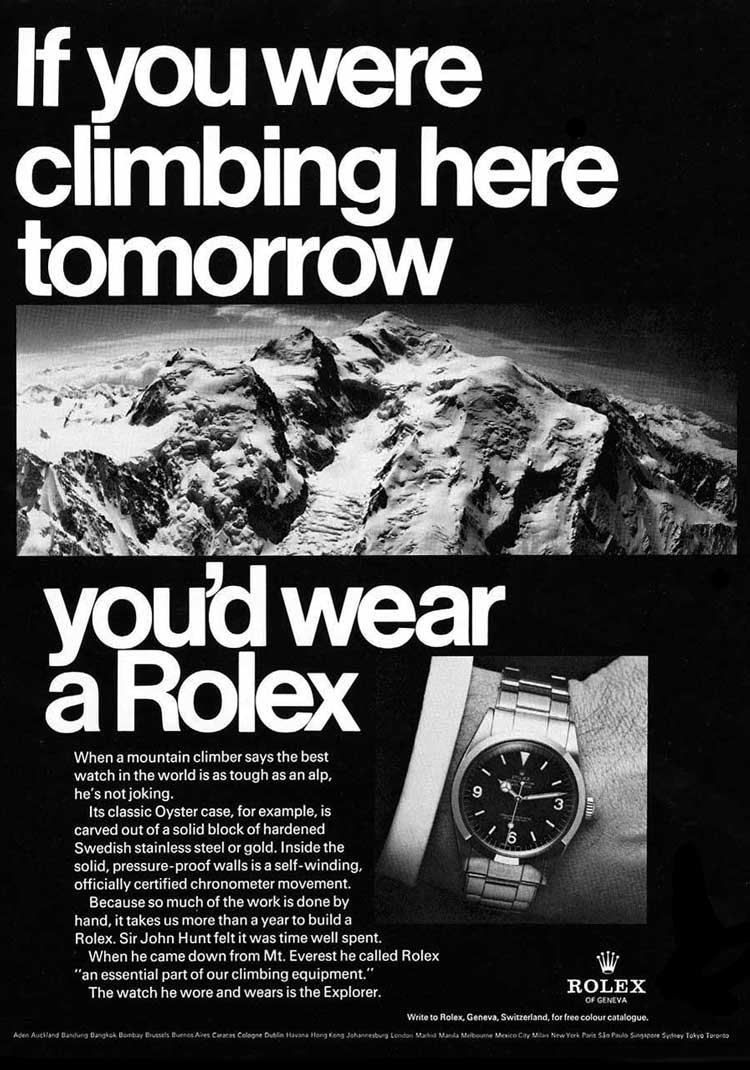
Old advertisements for the Rolex Explorer
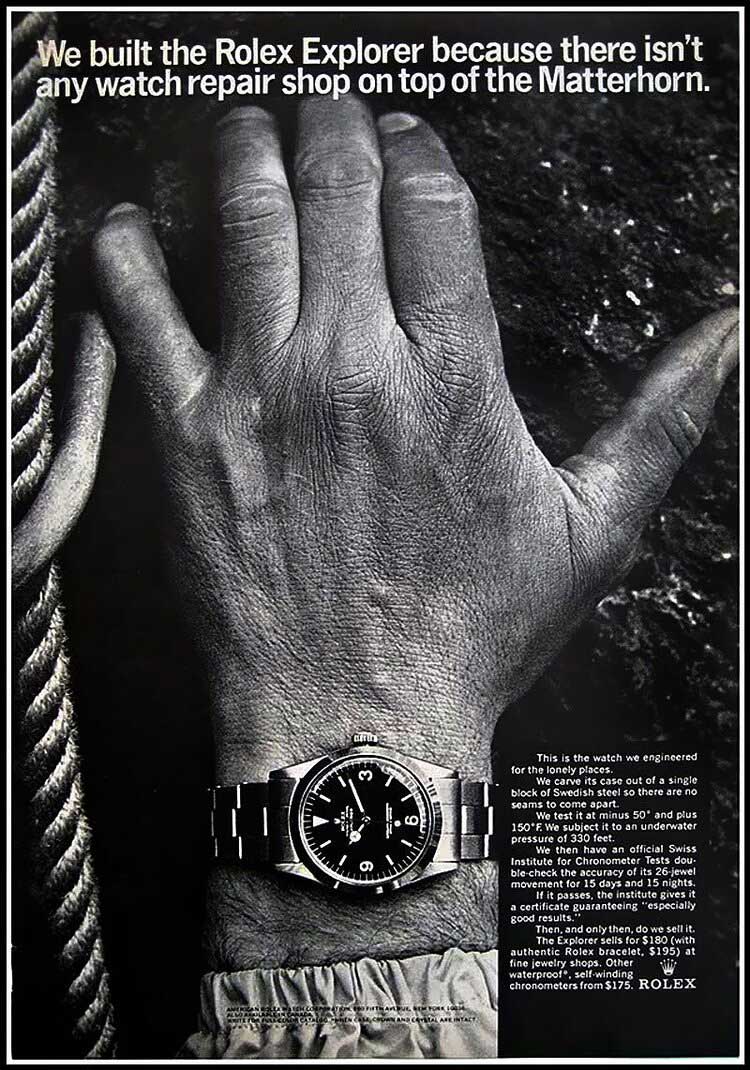
Old advertisements for the Rolex Explorer
Rolex Explorer unmatched durability: Built for adventurers
The story begins in 1952. It was a time when some of the world’s leading explorers were on the cusp of reaching the highest point on the planet – the peak of Mount Everest. Many attempts had been made and many lives lost, but the British mountaineers of the early 1950s were ultimately the men that would conquer the mighty mountain. Rolex were adamant that they wanted their watches on the summit and so in 1952 they equipped the British climbers with large size Oyster watches. These watches were what collectors now refer to as Pre-Explorers, essentially prototypes of what would ultimately become the Explorer.
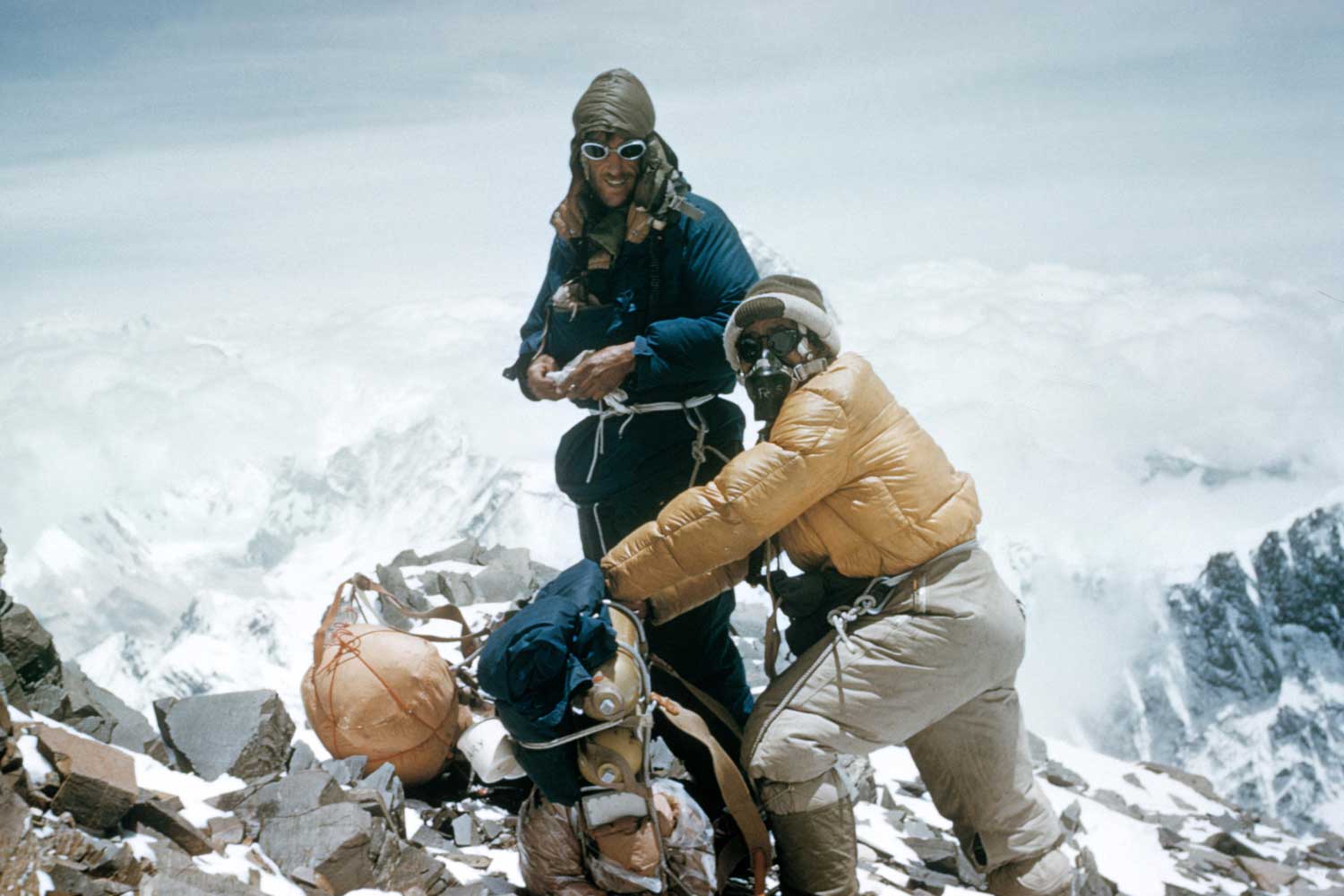
New Zealander Sir Edmund Hillary and Tenzing Norgay, a Nepali Sherpa climber, were the first successful pair from John Hunt's British expedition, and the first in the world to have reached the summit of Mt. Everest. These climbers were given the Rolex reference 6098 big bubbleback watches.
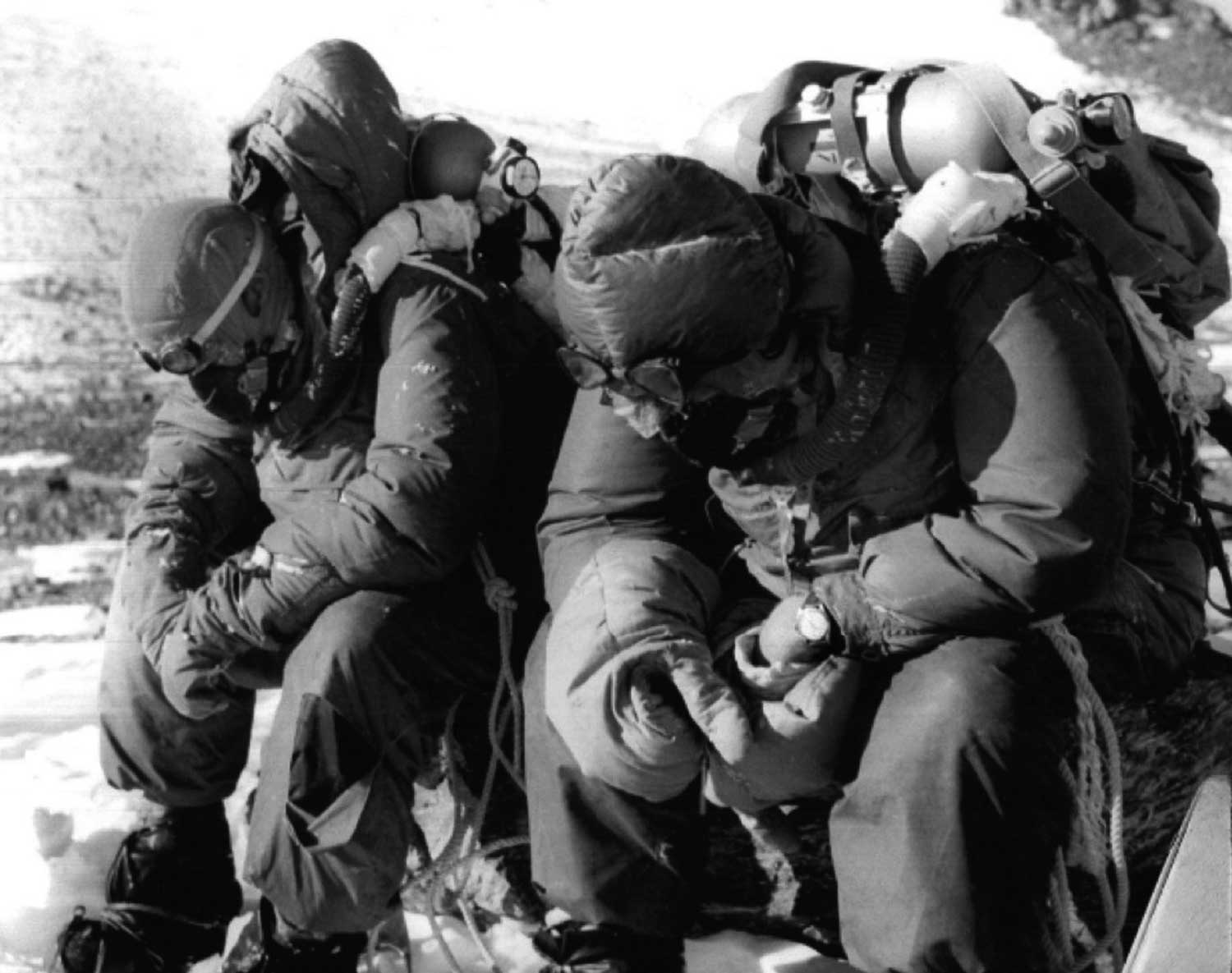
Tom Bourdillon and Charles Evans were the first pair from Sir John Hunt’s team to make the attempt for the summit; they were unable due to exhaustion, problems with their closed-circuit oxygen sets and time running out.
A Rolex made to conquer the Everest
In 1952 a number of climbers travelled to the Tibet and China border as part of a research trip in preparation for the 1953 assault of Everest. The destination was a mountain called Cho Oyu, 20km to the west of Everest. Included in the party were some of the key players in the famous 1953 expedition including Edmund Hillary, Charles Evans and Alfred Gregory. The watches given to these climbers were reference 6098 big bubbleback watches. Newly uncovered documentation informs us that Rolex provided twenty 6098s for the team in two batches (the first seven in 1952 to the advance research team and the second batch of thirteen to the remaining expedition members who hadn’t been on the research trip the year before).
The big bubbleback watches are more commonly known by their Italian nickname – Ovettone and are key watches in the development of the Explorer. The story began in the late 1940s with the 5020 series watches. Ovettone is Italian for ‘big egg’ and describes the large domed casebacks and crystals. The second series of Ovettone that Rolex produced were reference 6098 (the Everest watches) which like the 5020 series watches were of monoblocco construction (the mid-case and bezel were made from one block of steel) and featured the newly designed Super Oyster Crown, which didn’t screw down but just pushed in like regular dress watches. The 6098s were powered by the A296 perpetual movement, which was very thick and therefore necessitated the prominently domed case back. The 6098 watches were also chronometer rated and the accuracy of these watches was one of the key aspects that Rolex were keen to see test results of when the expedition team returned.
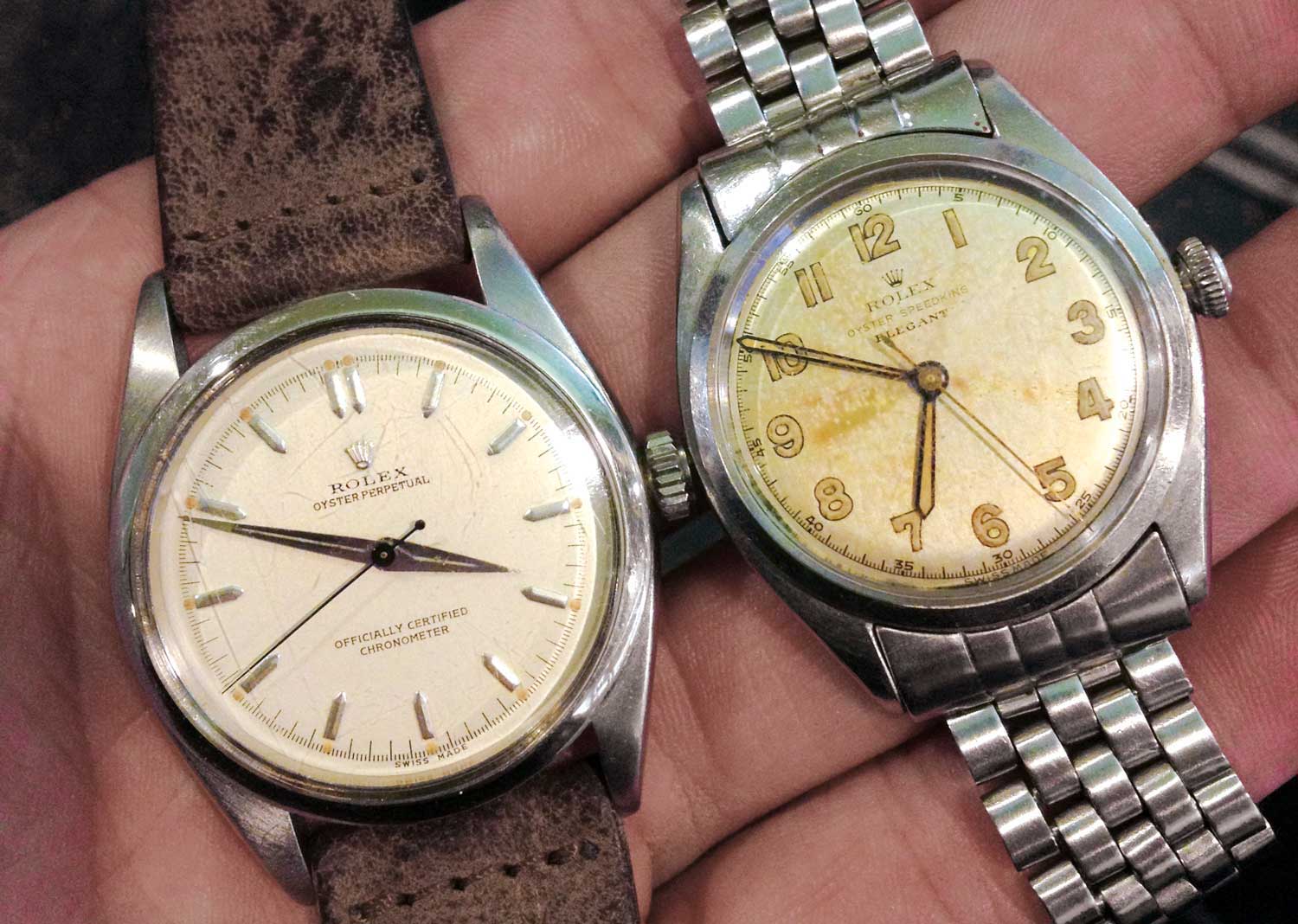
Rolex Explorers ref. 6098 and ref. 5028 “Ovettone” (Image © Philipp Stahl, Rolex Passion Report)
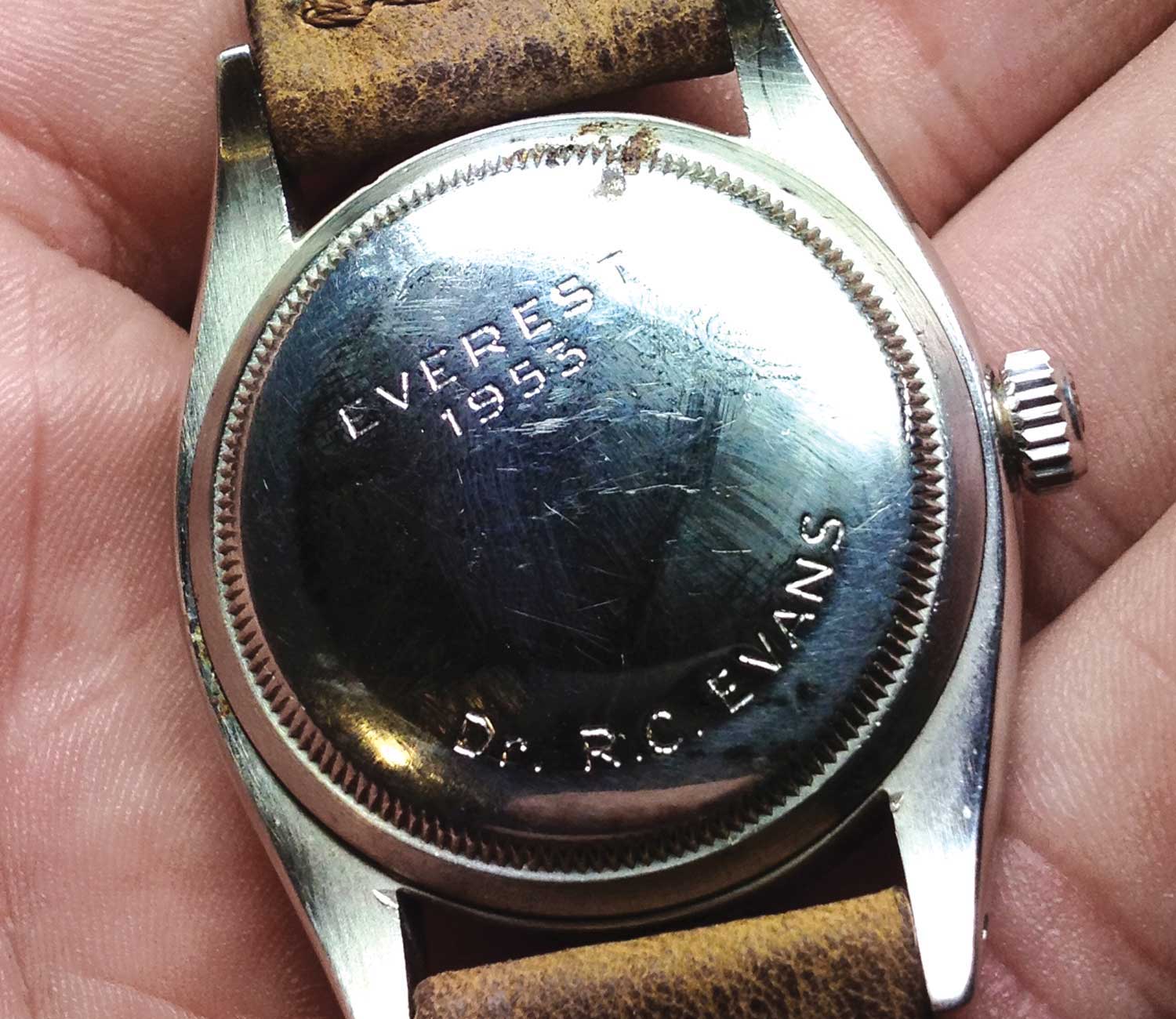
Caseback engraving of the 6098 belonging to Dr. Robert Charles Evans (Image © Philipp Stahl, Rolex Passion Report)
Rolex explorer 6298 referred to as the Everest dials
Never standing still, this was a time of very fast research and development for Rolex and later on in 1953 Rolex launched the improved pre-Explorer reference 6298. This watch now had the new three-piece case. These watches had a separate mid case and bezel. The bezel was used to secure the new tropic crystals to the mid case and create a watertight system. The previous Super Oyster Crown had proven to be prone to leakage and so the 6298s had the new improved ‘brevet +’ 6mm screw down crown. Still using the A296 calibre the watch retained the large domed caseback and is very much an ovettone. Both the 6098 and 6298 featured characteristically 1950s Rolex Oyster dials with closed minute track, applied arrow hour markers and applied Rolex coronet. Collectors refer to these as the ‘Everest’ dials now.
The black dial 3-6-9
Whilst it was used previously, Rolex officially rolled out the black 3-6-9 dial with reference 6150 and 6350 – the successors of the 6098 and 6298. Again, both references utilised the A296 ‘big bubbleback’ movement and the three-piece Ovettone cases. The difference was the dial layout. This was the true origin of what we see today on the Explorer. The inverted triangle at the top of the dial, printed Rolex text and coronet and the painted 3-6-9 numerals. The addition of Mercedes pattern hands also came with reference 6150 and 6350, although there were watches that were fitted with ‘pencil’ hands, like those seen on the reference 6204/5 Submariner too. The only difference between these two models was that the 6150 was designated Precision and the 6350 was chronometer rated (OFFICIALLY CERTIFIED CHRONOMETER – OCC). Yes, they used the same movement but the OCC were fine tuned to better precision. The 6350 was also the first reference to wear the mighty moniker – EXPLORER! To many collectors this watch is the first Explorer proper. Collectors particularly look for the very rare version with a honeycomb dial; it is stunning!
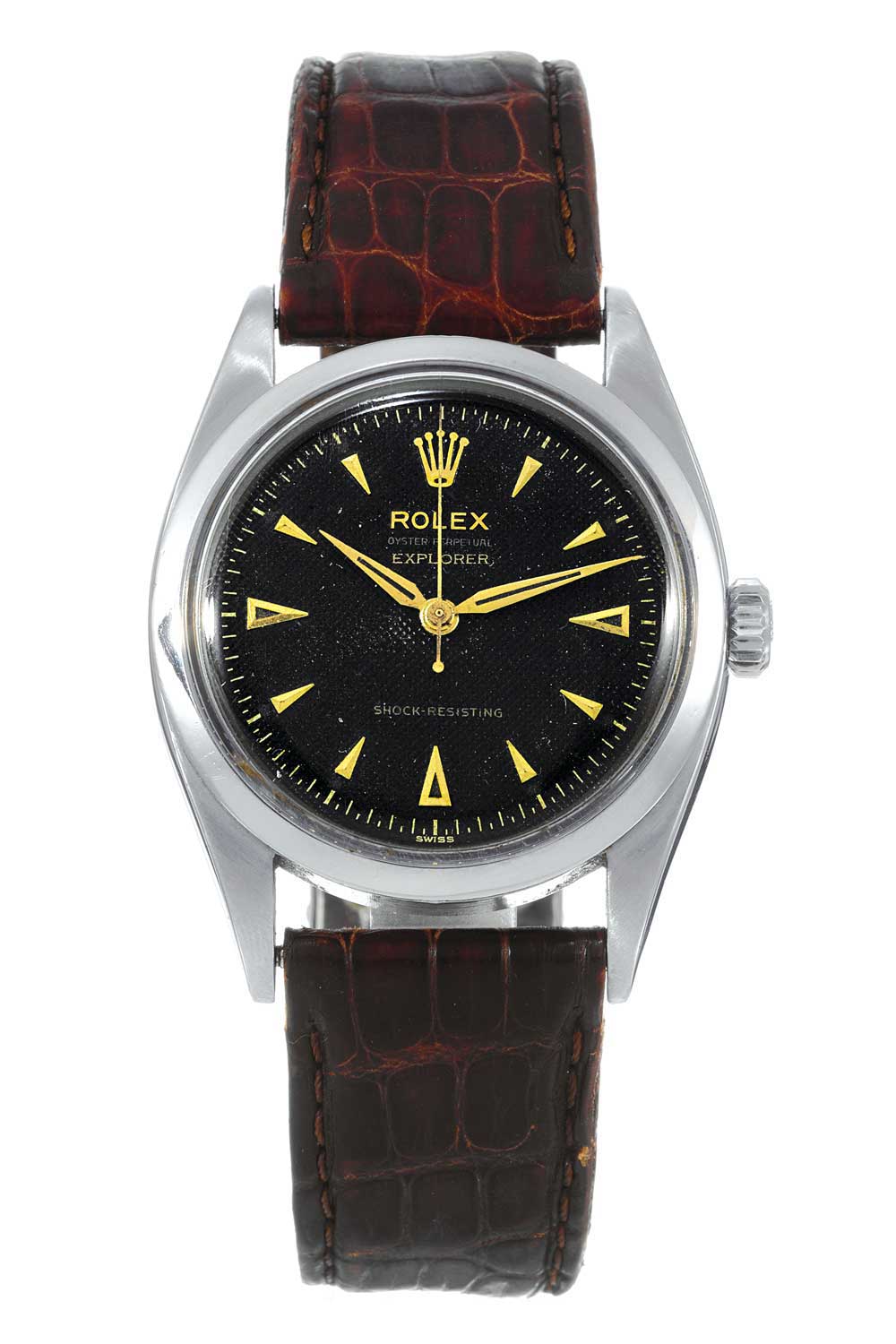
Rolex Explorer ref. 6298 with black dial. Both 6298 and 6098 featured characteristically 1950s Rolex Oyster dials with closed minute track, applied arrow hour markers and applied Rolex coronet.
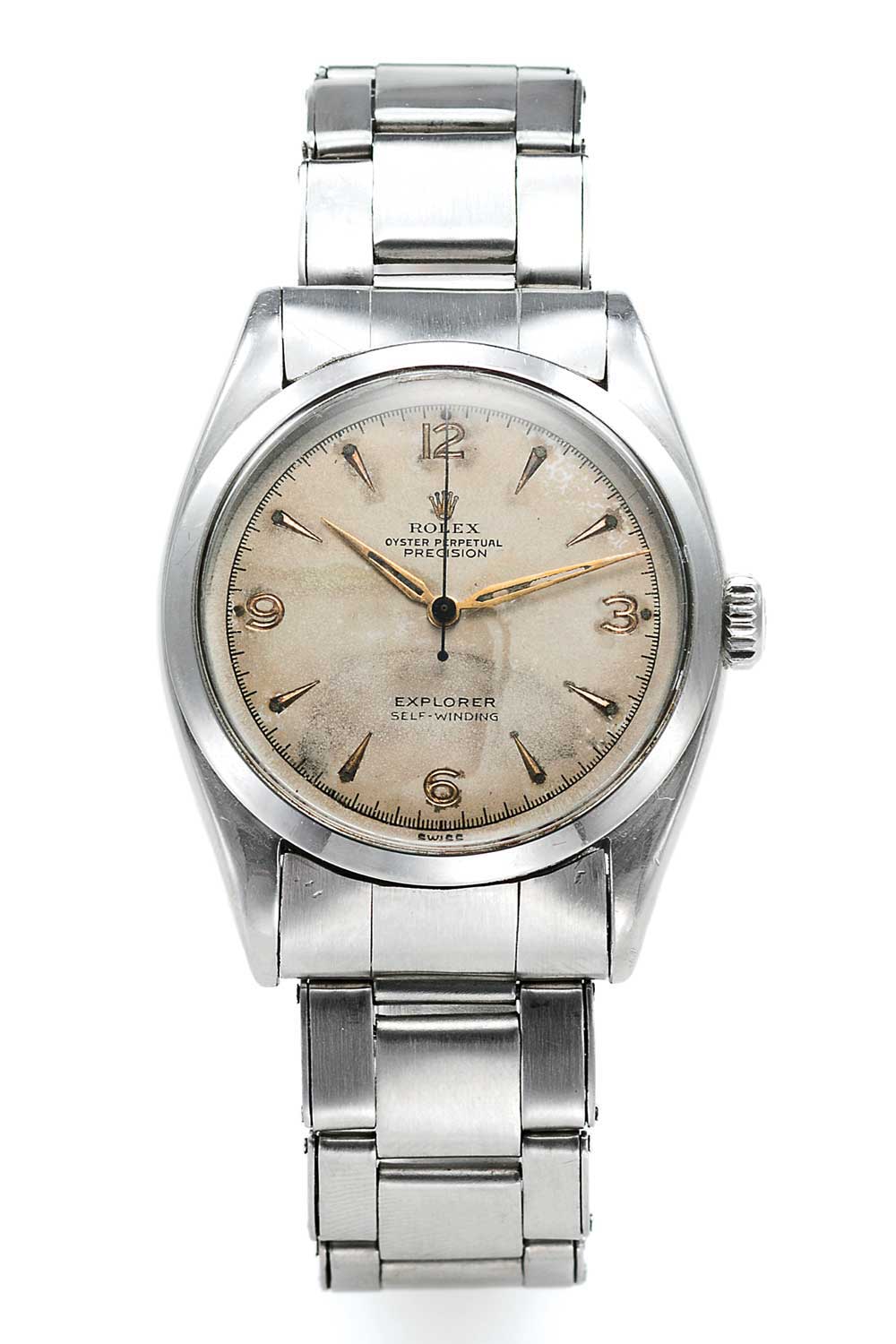
Rolex Explorer ref. 6298 with matte-silver dials. The model had the new improved ‘brevet +’ 6mm screw down crown.
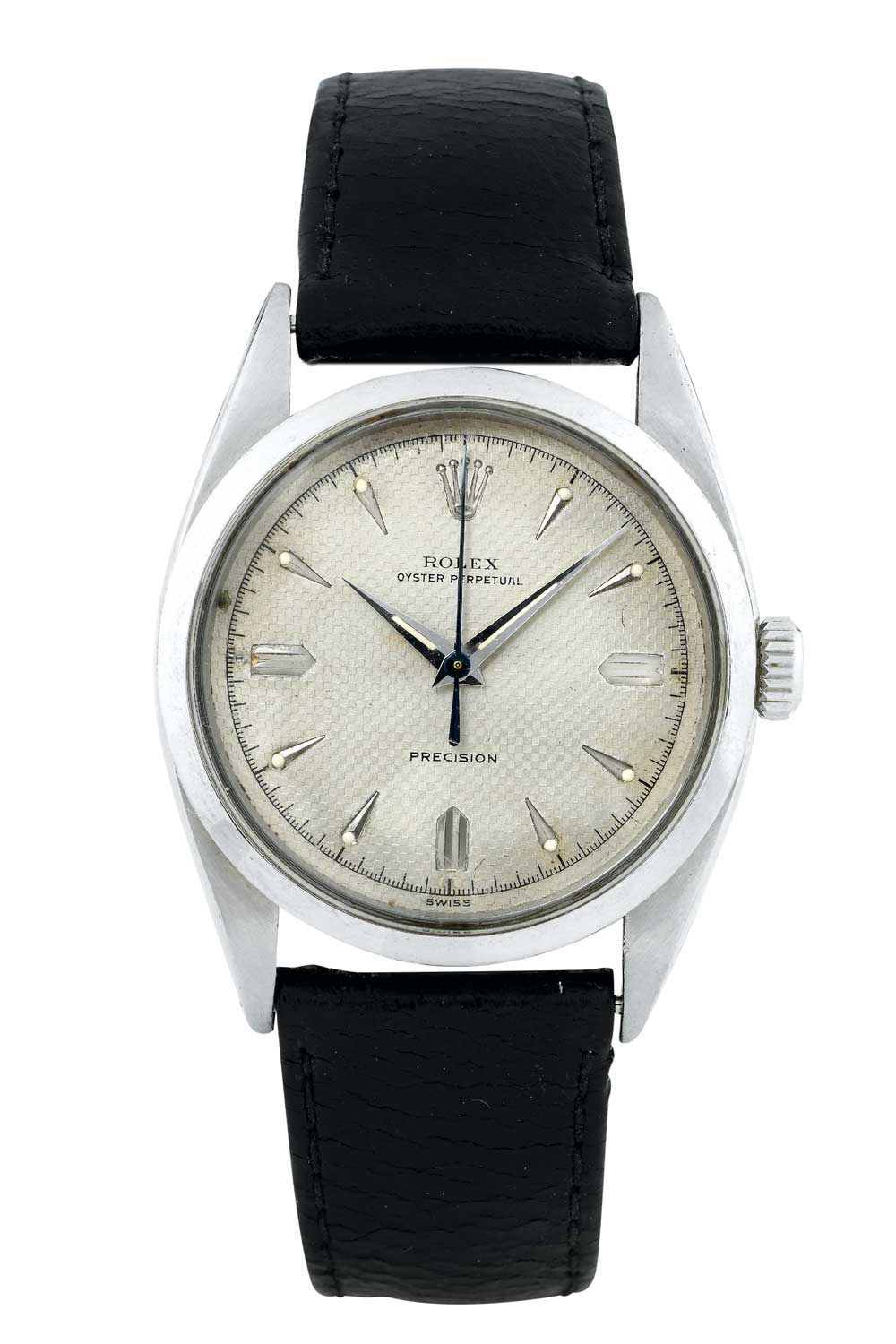
Rolex Explorer ref. 6098 belonging to Alfred Gregory
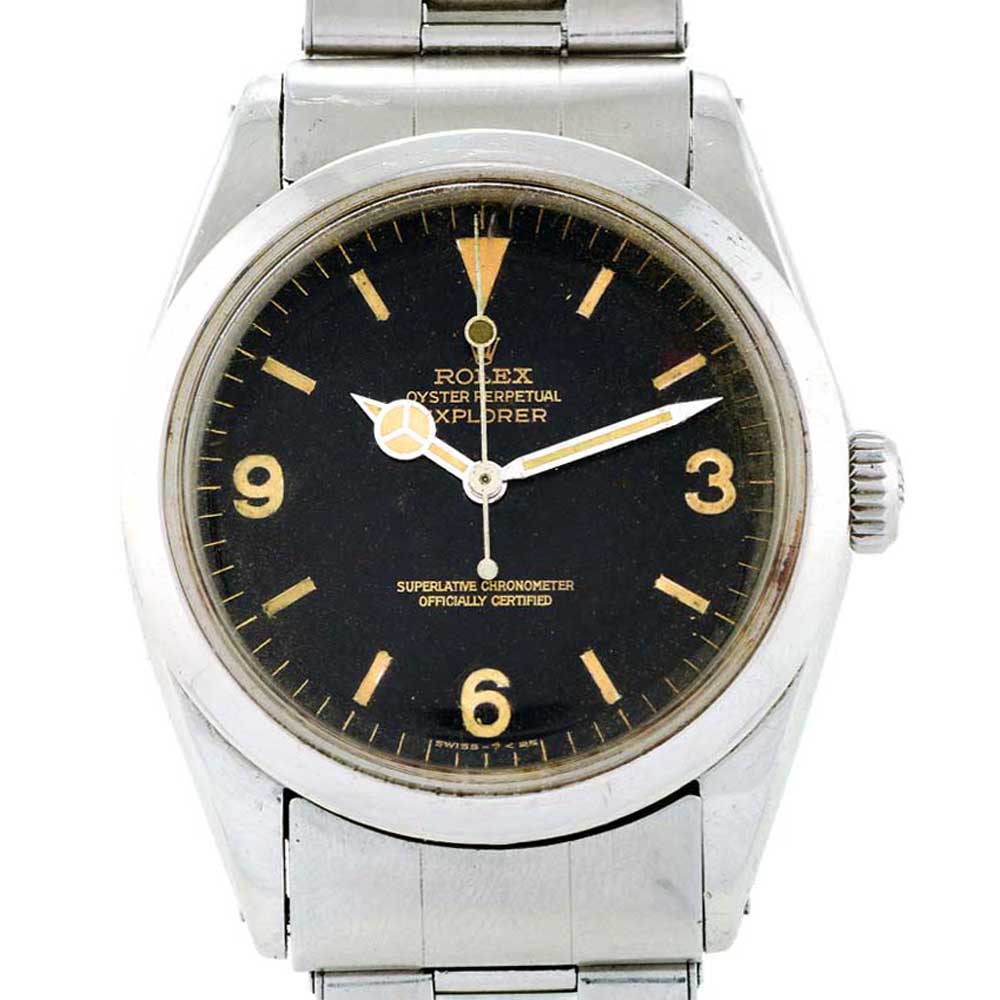
Rolex Explorer ref. 6150 featuring a Mercedes hour hand
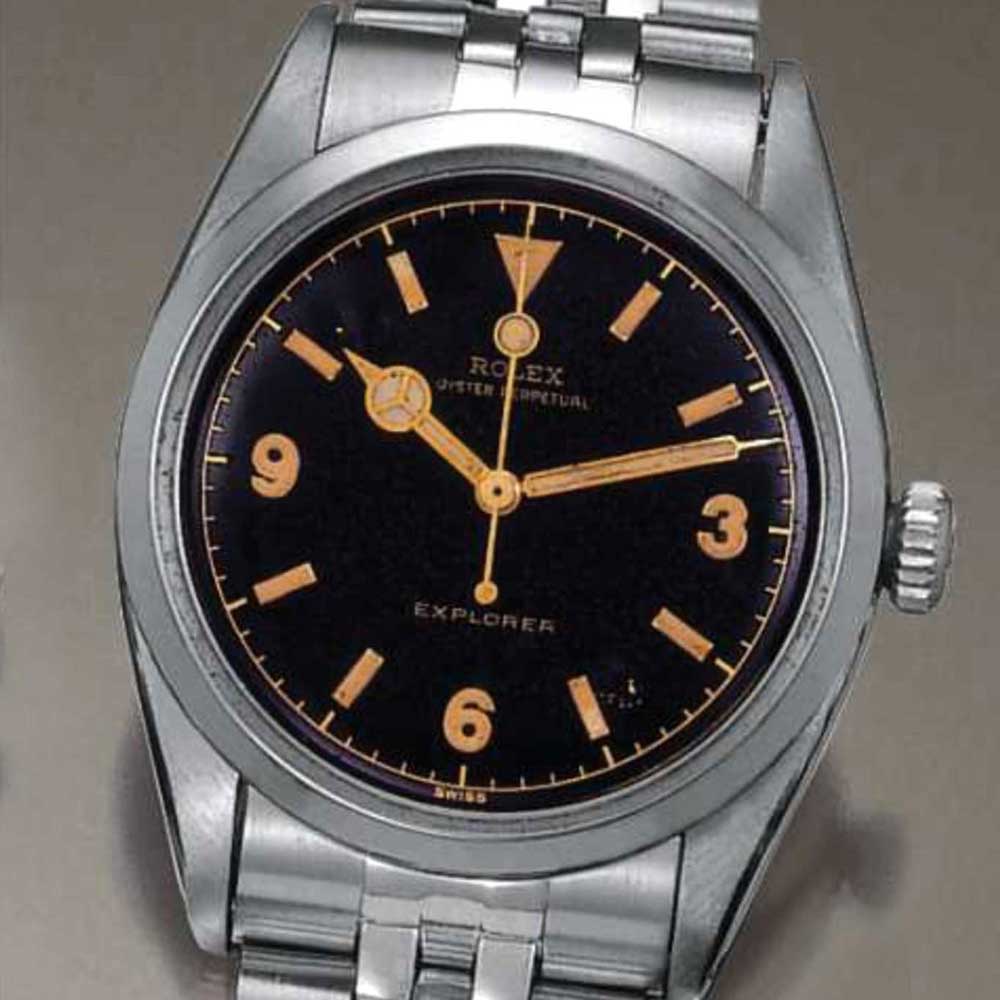
The Rolex Explorer ref. 6350 with “pencil” hands was the first reference to wear the mighty moniker – ‘EXPLORER’.
Caliber 1030 led Rolex Explorer into a new era
In the mid 1950s Rolex introduced their new movement, the caliber 1030. This new movement was Rolex’s first complete in-house built and designed movement and was chronometer rated. This next generation movement required a new generation Explorer and so the Wilsdorf Empire gave birth to the reference 6610 in approximately 1956. The newly launched caliber 1030 was a lot slimmer than its ‘bubbleback’ predecessors and so a new case design was produced that was still well proportioned at 36mm with a 20mm lug width. The slimmer movement meant that a flatter caseback could be fitted to the watch and it was this shape that became the standard for many years to come.
The 6610 also fully embraced the standard Explorer aesthetic. The dials had the inverted triangle at twelve o’clock and the 3-6-9 numerals and now Mercedes pattern hands were always present. All the dials were gilt too. The term gilt can be misused and so to be clear, when discussing vintage Rolex dials the gilt refers to the glossy black dials with the text in a gold (gilt) colour. The text is not actually printed on the gloss, but is actually relief print and the gilt text is the brass base plate of the dial showing through; a production method known as galvanic process. The dial then had a lacquer applied to protect it. There are some very rare 6610 that had an additional line of text that was printed onto the top of the dial in either red or silver; a depth rating (50m = 165 ft). This was a way for Rolex to demonstrate the capabilities of the watch for all sports and methods of exploration. Another rare version of the 6610 had a painted white seconds hand; it’s always about the minute details with Rolex!
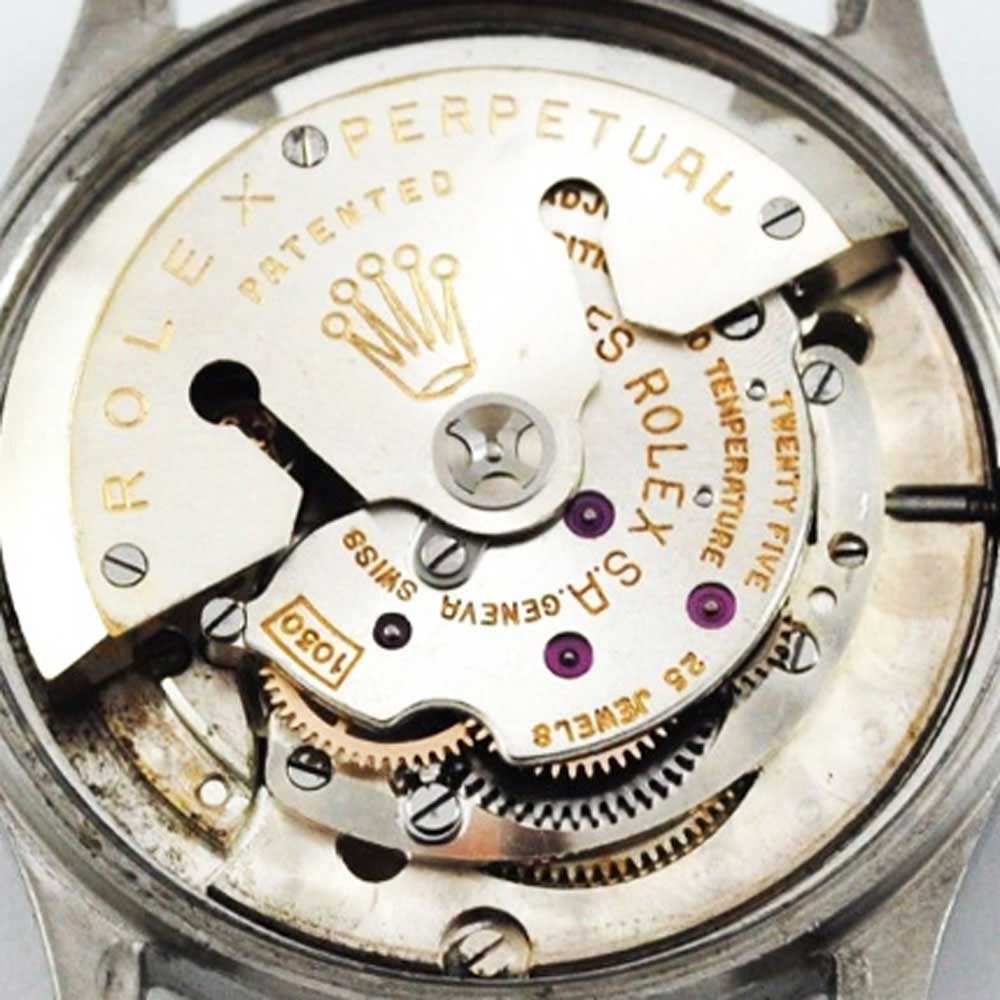
The chronometer-grade cal. 1030 introduced in the 1950s was Rolex's first fully in-house movement
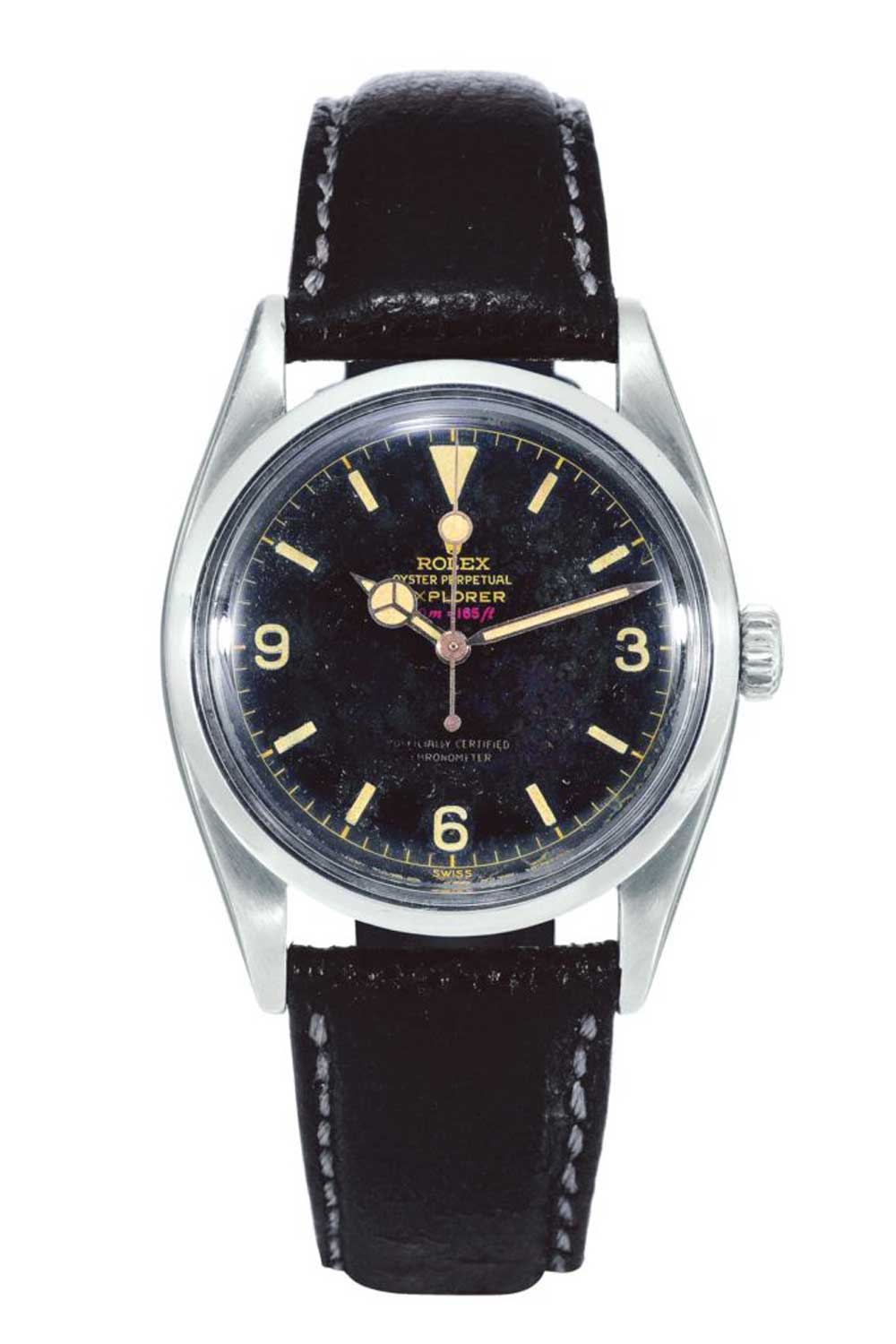
Rolex Explorer Ref. 6610s: an additional line of text printed on the top of the dial in red for the depth rating
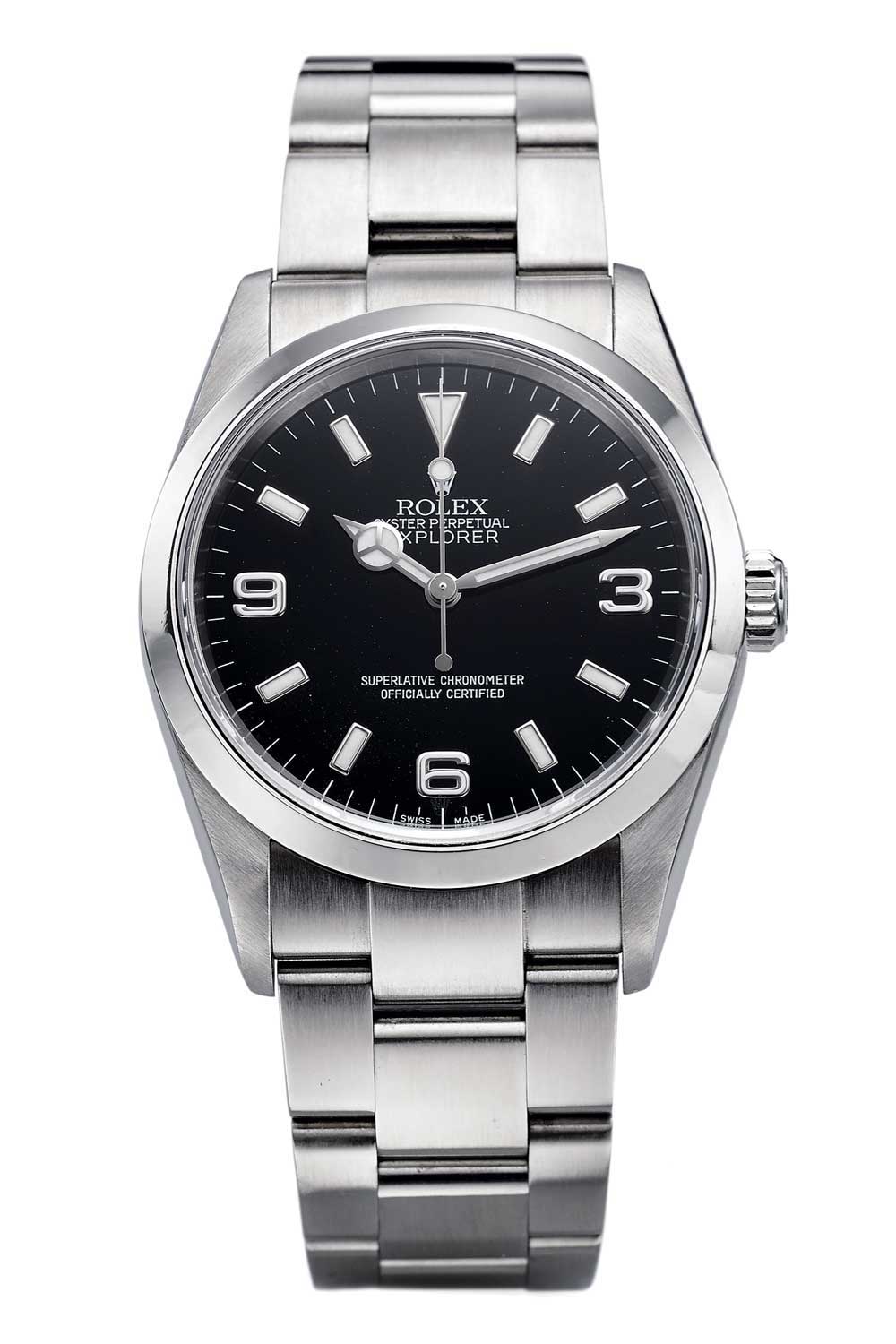
A seconds hand painted in white
Rolex Explorer 1016 the longest running sports watch references
In 1963 Rolex unveiled what would become one of the longest running sports watch references, the Explorer reference 1016. Production ceased in 1989 and in essence not a lot changed on the watch, except some minor details…which is what it’s all about! Again, the 1016 was heralded by the latest movement improvement by Rolex, the caliber 1560. A chronometer rated movement, it became the staple in Rolex Oyster watches of the era. A decade later there was minor improvement to the caliber with the introduction of the 1570 which had a hacking (or stop-seconds) feature added. The 1016s were also rated to a slightly deeper depth rating at 100m.
One of the biggest changes that occurred in the lifespan of the 1016 was the shift in what was used for the luminous materials on the dials in the hands. Up until the early to mid 1960s Radium had been used. It became apparent that it was completely unsafe and had potentially catastrophic effects on health and so Rolex moved to using the safer option of tritium. This was signified by the new ‘SWISS T<25 or T-SWISS-T’ on the bottom edge of dials replacing the ‘SWISS’ which had been there previously. This switch began in 1963 and was transitional over a number of years. In the late 1960s a new type of dial began to appear on Rolex sports watches and relevantly here, the 1016 Explorer. Known as matte dials, these dials had a matte black finish and the text was printed onto the dial surface.
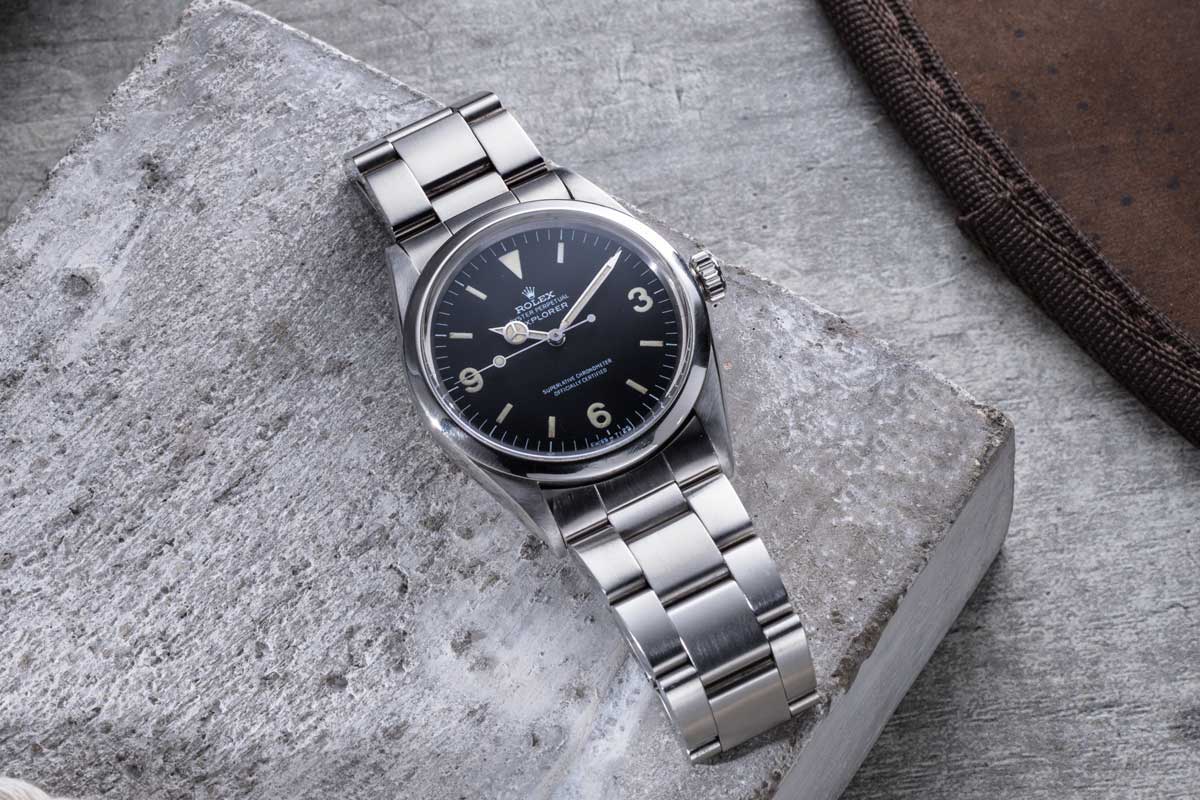
An early 1970s matte so-called 'Frog Foot' Rolex Explorer ref.1016 (©Revolution)
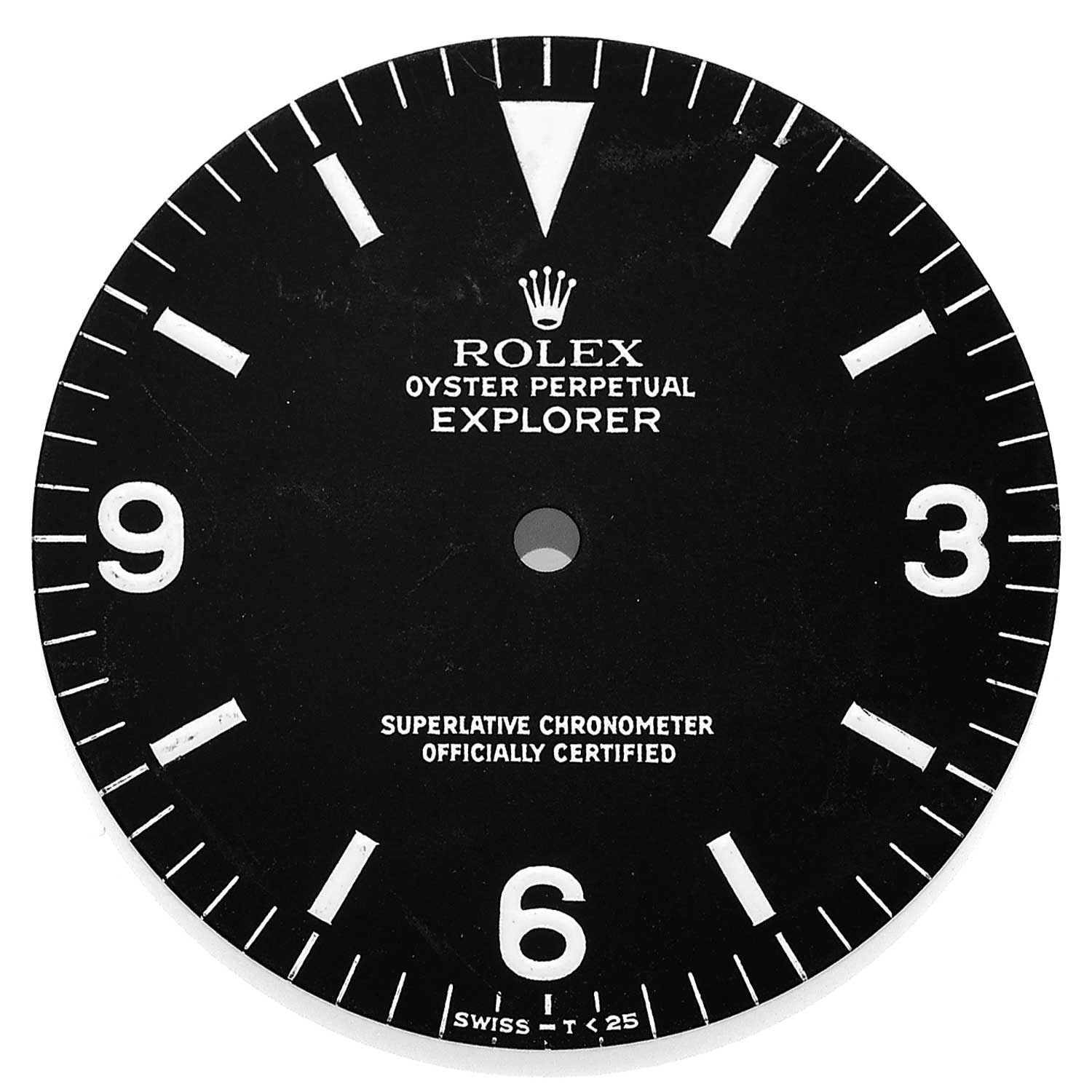
Rolex Explorer ref. 1016 Tritium dial
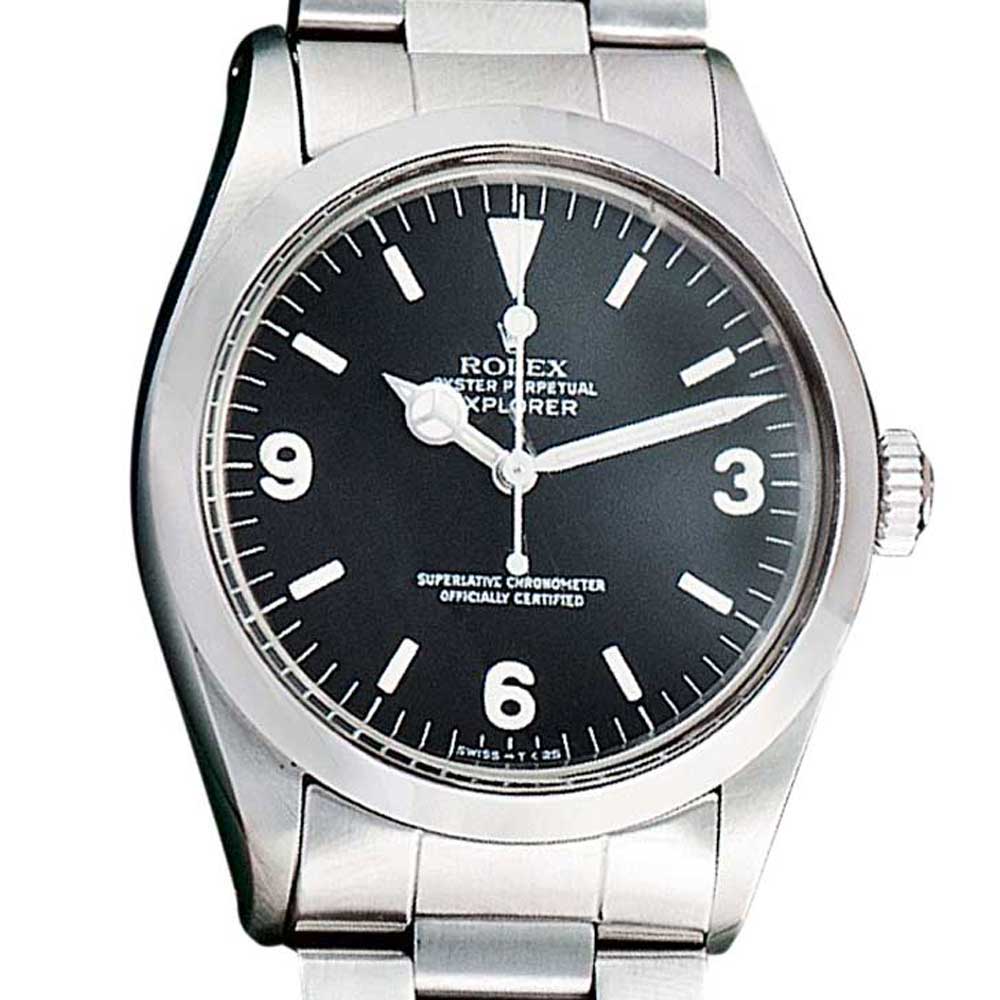
The Rolex Explorer ref. 1016 with hacking feature
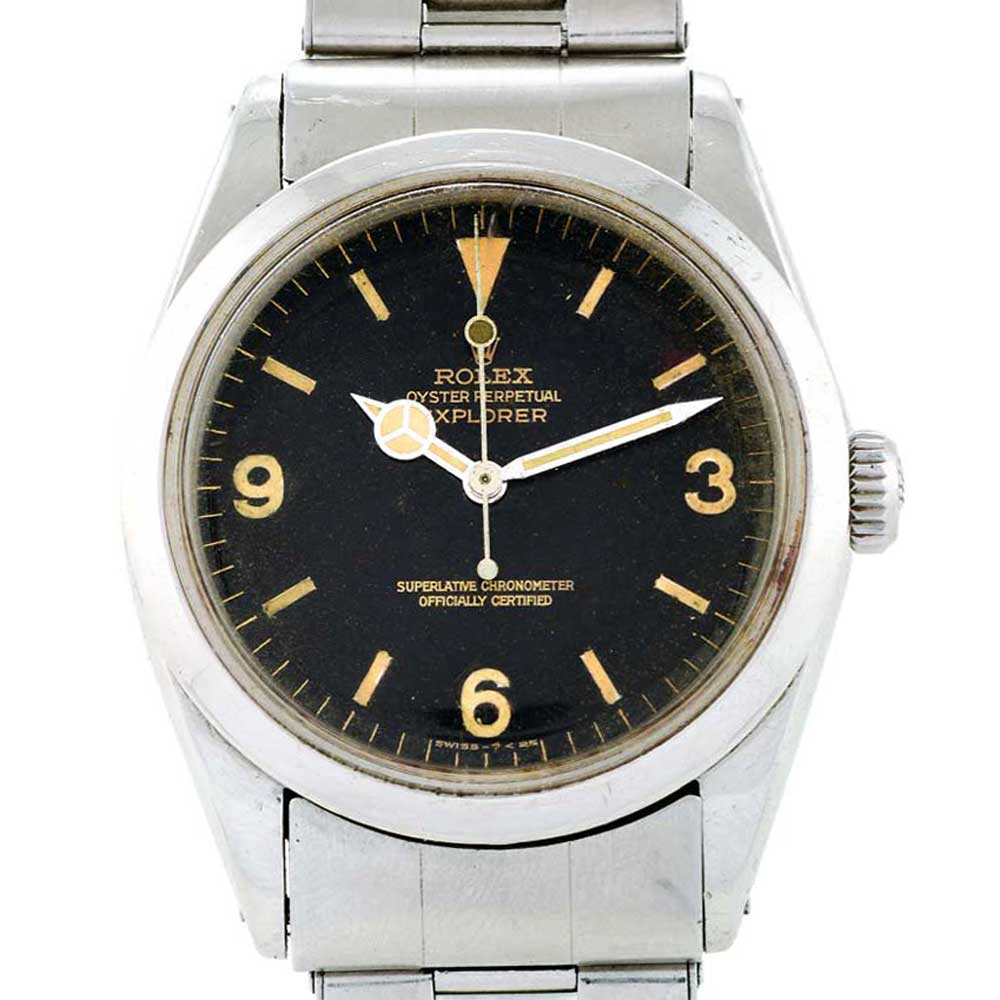
The Rolex Explorer ref. 1016 with gilt dial
A new Rolex Explorer generation is launched in the eighties
Towards the end of the 1980s Rolex introduced the next generation Explorer. The reference 14720 was a very different watch, but as per the Rolex way, the core DNA was still present. The acrylic crystal was replaced with a scratch-resistant sapphire glass, which gave the watch a more ‘modern’ feel on the wrist. The dial, whilst maintaining the iconic 3-6-9 layout replaced the painted numerals with white gold numbers that were filled with luminous material; initially tritium and then in the late 1990s Rolex moved to using luminova for their lume. The watch was powered by the newly introduced caliber 3000. The 14720 ran for almost a decade until it was superseded by the reference 114720 in 2000; a watch with a second generation 3000 series movement, the 3130.
Which model qualifies as vintage?
Collectors of vintage Rolex watches are divided about what actually constitutes a ‘vintage’ piece. The majority would probably argue that the switch from acrylic crystals to sapphire is the shut off. As time passes, however, the early sapphire crystal watches are becoming more sought after as acrylic (or plexi) Rolex watches gain spectacularly in value. Another key point to note is that quality control and production was much tighter now at Rolex and so the multitude of small variations seen between the 1950s and 1970s in sports watches was largely eradicated by the 1990s. There are some interesting small differences in these models. One is the vintage-esque drilled lug holes seen in early 14720, which were phased out relatively early in the watch’s run. In 1990 (where the corresponding Rolex serial numbers began with the letter E) the 14720 was produced with a dial version where the 3-6-9 numerals were filled with black enamel instead of tritium. This wasn’t received well and so Rolex reverted back to filling the numerals with luminous material almost immediately. This version has been given the nickname ‘Black-Out’ by collectors and is probably the rarest modern Rolex watch.
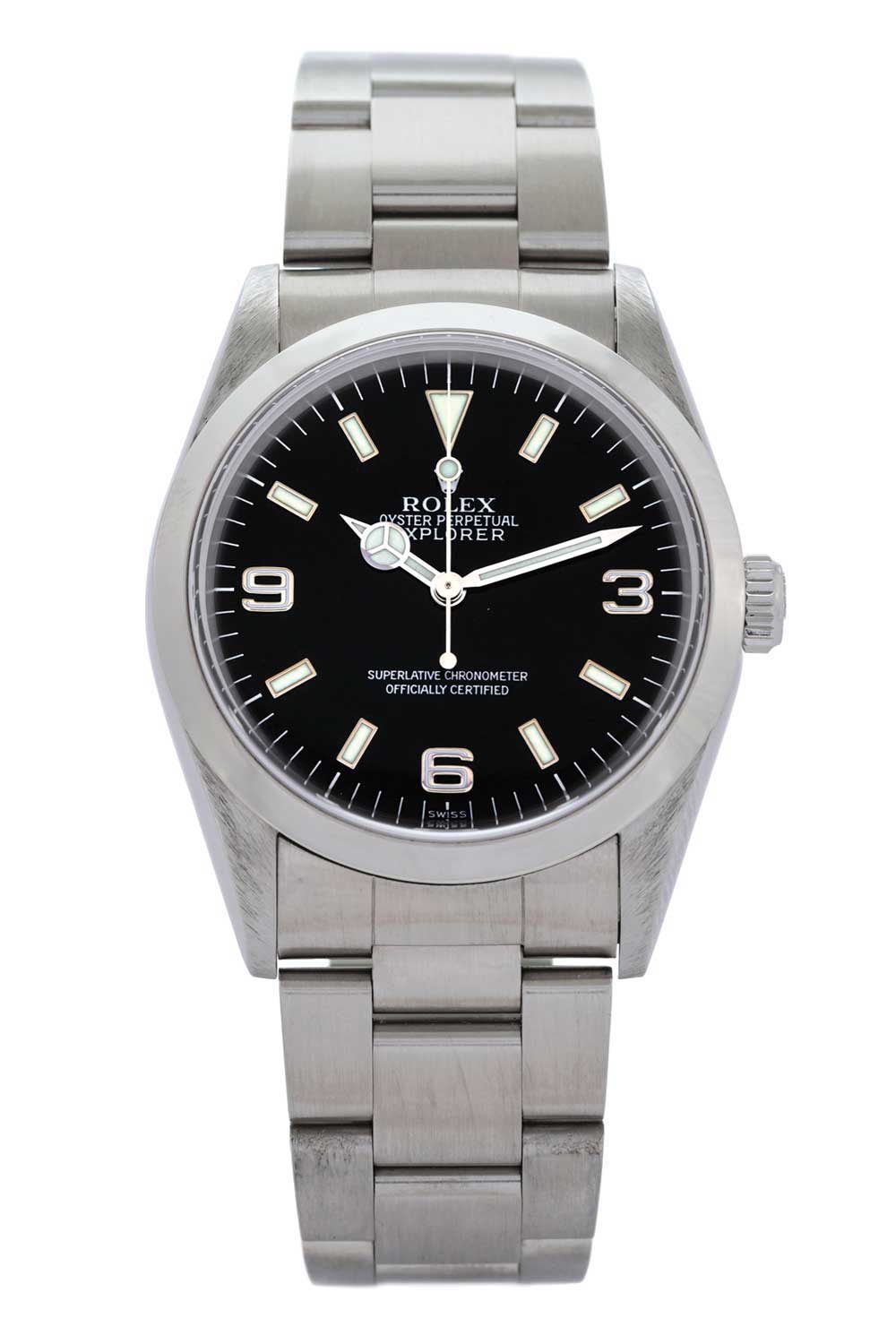
Introduced in the late 1980s, the Rolex Explorer ref. 14270 was in production for almost a decade
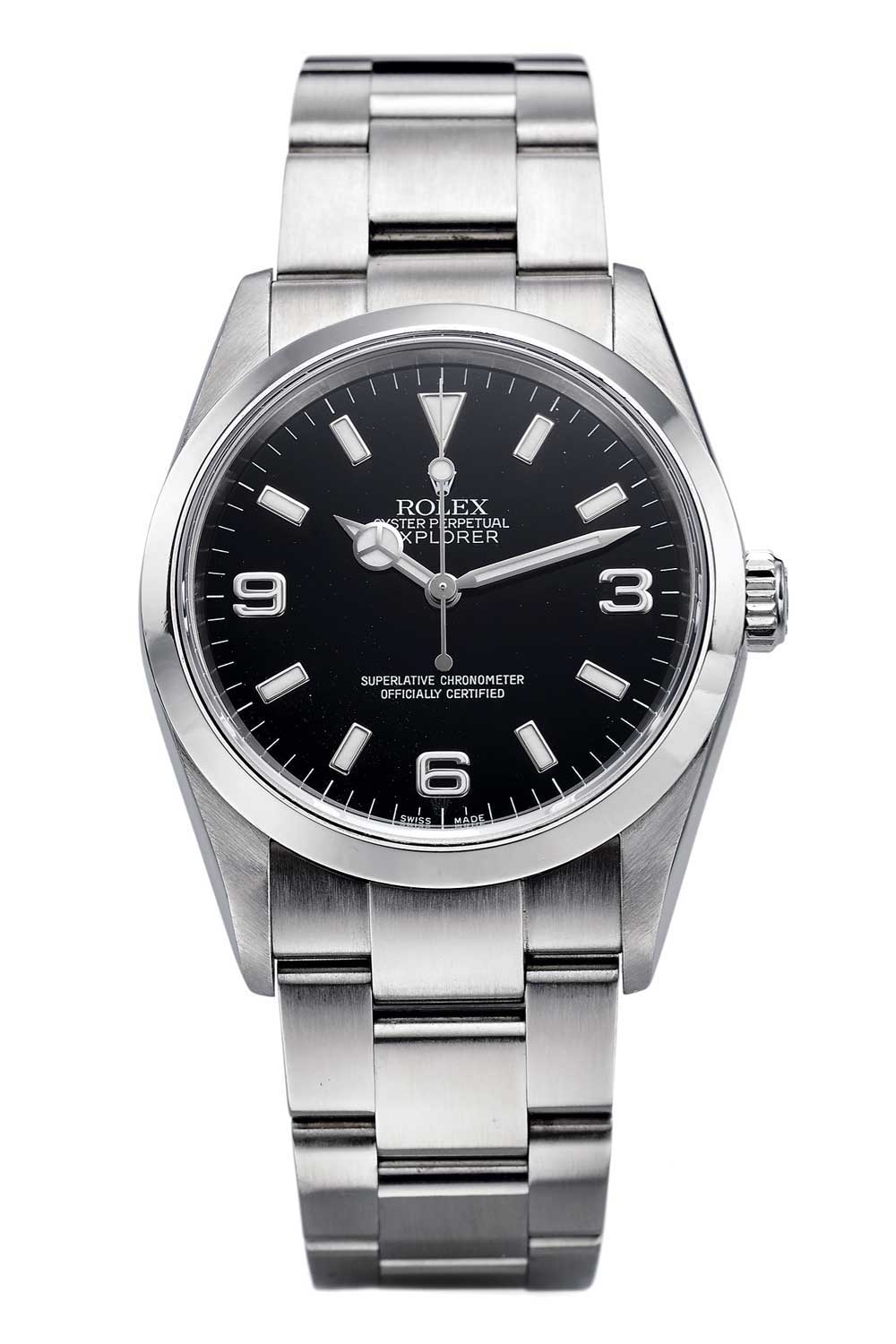
The Rolex Explorer ref. 114270 launched circa 2000 succeeded the ref. 14270
Supersized me, with the reference 214720
Then in 2010 Rolex supersized the Explorer with the reference 214720 at Baselworld. Featuring the caliber 3132, the watch was housed in a big 39mm case (nearly as big as a Submariner!) and the word EXPLORER had been moved to the bottom half of the dial. The other noticeable change was the removal of luminous material (by now Rolex’s new blue Chromalight) from the numerals, which were solid white gold –remind you of the ‘Black-Out’ 14720? The lack of luminous material in the 3-6-9 was not well received (and the hands were criticized as being too short) and so the dial and hands were reworked for the current version. Collectors take note – the Mk1 214720 is surely a future rarity!
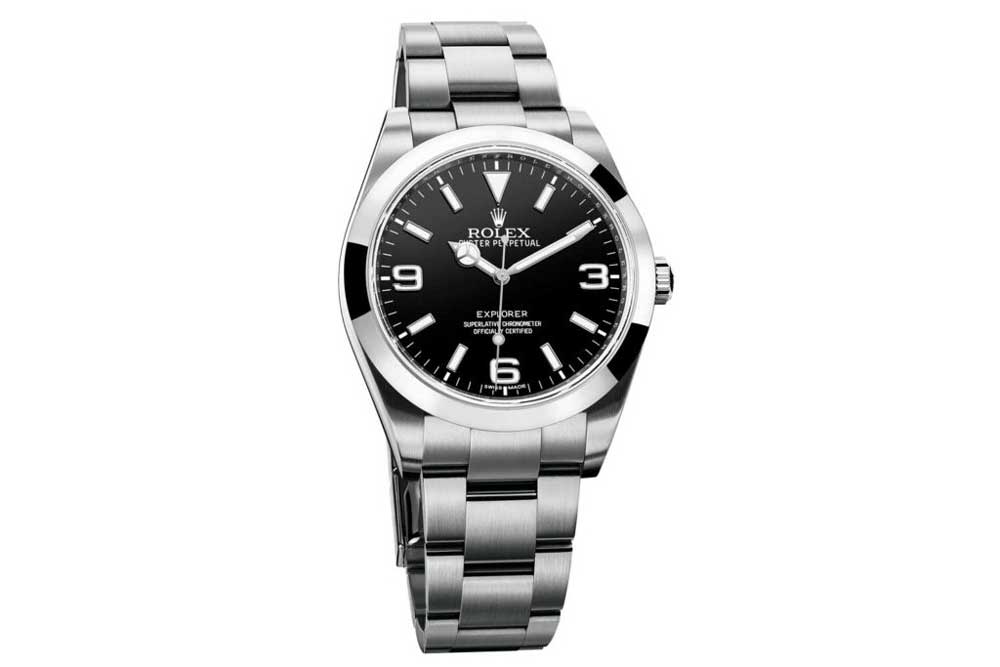
Rolex Explorer ref. 214270
Back to the roots in 2020
Now in 2021, Rolex has gone back to 36mm with the Explorer. The 36mm Oyster case has always been the sweet spot for Rolex, in my opinion, and so it makes total sense that the Explorer returns to its original proportions. Following hot on the heels of last year’s super-hot ‘stella’ dial Oyster Perpetual 36, Rolex has relaunched its Explorer in its familiar 36mm guise and has expanded the line with a Rolesor yellow gold and Oystersteel version.
Following on from the Seadweller a couple of years ago, the Explorer now has this treatment and it’s a solid move by the brand, thanks to the recent surge in interest in steel and gold watches. The layout is familiar classic Explorer with applied Arabic numerals at three, six and nine with Chromalight luminous material in these and the other applied baton hour markers. The reference number is 124273 and the watch has a yellow gold winding crown, bezel and centre-links on the Oyster bracelet.
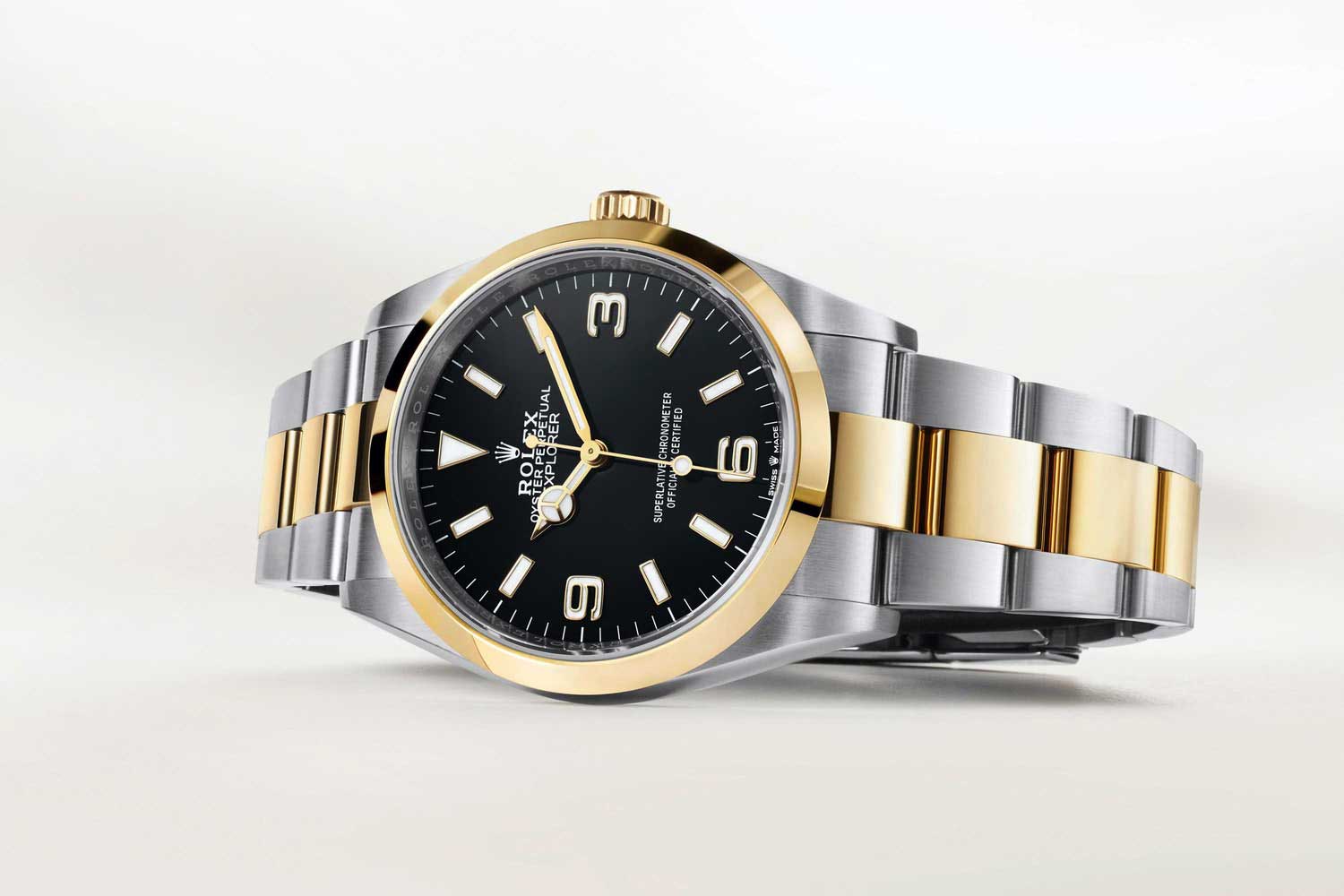
This year, Rolex relaunched the Explorer in its familiar 36mm guise and expanded the line with a Rolesor yellow gold and Oystersteel version.










